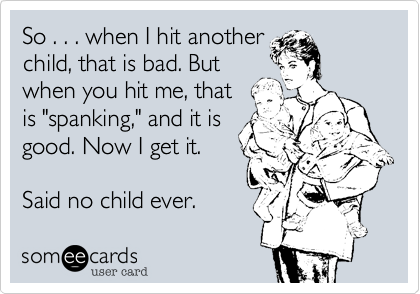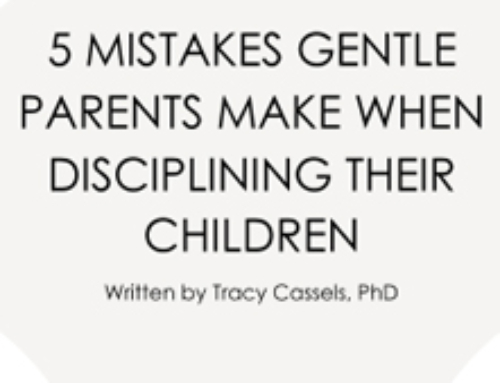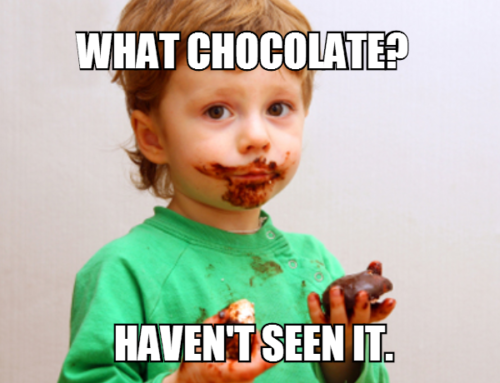
Spanking is still – unfortunately – a common way to “discipline” young children. Only a handful of countries have banned the practice, despite the fact that there is significant amounts of research showing detrimental effects to children. Cultural norms surrounding spanking result in parents believing it is a valid tool to obtain compliance from their children and that it can “socialize” them to be better people. Adults share stories of the “whoopings” they got as kids and some even attribute their respect for others to these behaviours.
I would beg to differ on many levels. If we start with the fact that spanking only serves to instill fear and pain, not the type of socialization that we often hope and expect for our kids. Yes, it can lead to short-term compliance because the brain responds to that fear and pain often with freezing – it’s a threat to our survival, so we shut down a bit. This happens to look like compliance, but has nothing to do with a child knowing right or wrong. As for those adults who like to claim spanking gave them respect for others? I have heard it said that if you think hitting someone smaller and weaking than you shows a level of respect for other people, your definition of respect may be a little out of whack.
Contrary to the idea of spanking teaching appropriate lessons, most research finds that spanking is associated with a host of poor outcomes across development, including internalizing problems (like anxiety and depression), externalizing behaviours (like acting out, violence), and even worse cognition. Although there is some research finding that these outcomes may be moderated by subculture, with some subcultures not showing such negative effects, by and large, these findings hold across studies.
Yet we still debate whether children need to be equally protected from violence (legally) as adults are. Perhaps some newer research may help push the scales in favour of ending this nonsensical practice.
What is the research?
Researchers from Harvard University, the University of North Carolina (Chapel Hill), and the University of Washington collaborated on a study examining potential neurological effects of having been spanked in the past (Cuartas et al., 2021). The researchers recruited 147 children (mean age of 11 years), 40 of whom had a history of being spanked and 107 of whom did not. The majority of the participants were White (66%). These children were part of a larger study that started at birth and for the current study, data collected at 10-12 years was used, including neuroimaging which was available for 183 children however the fMRI data for 10 participants was excluded due to poor quality and a further 26 participants were excluded as they had a history of physical or sexual abuse and therefore that could confound analyses on spanking; however, those children who endorsed abuse were considered their own category for the analyses.
Children were considered as having been spanked if they reported being spanked (using visual images to confirm this is what had happened to them) “a few times” or more. The children who were spanked were no different by gender, race or ethnicity, age or birthweight than those who were not spanked. However, those who had been spanked did have a lower socio-economic status than those who had not been spanked.
The neuroimaging part of the study involved an emotional face task whereby children were in the fMRI machine and images of faces would appear. There were three blocks of faces – neutral faces, fearful faces, and then scrambled faces. No block was displayed twice in a row. In order to ensure children were paying attention, they would be asked once in each block to report if the face they had just seen was male or female.
What did they find?
As expected, overall fearful faces resulted in greater neurological activation, especially in areas of the brain associated with threat and emotional stimuli, such as amygdala and hippocampus (amongst others). There was also widespread activation of the prefrontal cortext (PFC) to fearful faces.
When spanking was considered as a variable, children who were spanked showed significantly higher activation in various regions of the PFC, including areas of the left middle frontal gyrus and the bilateral dorsomedial prefrontal cortex, but not the amygdala. Perhaps most chillingly, there were no areas of the brain that showed any differences when comparing fearful to neutral faces between the children who were spanked and those who had a history of severe abuse (physical or sexual). Both groups differed from the non-spanking group, but not from each other.
What does this mean?
The emotional face task is often used to determine response to threat or perception of threat. In the current study, the results suggest that children who have been spanked a few times or more (relative to “one time” or “never”) are more prone to processing or seeing threat and may struggle with emotion regulation more. The areas of the brain in which they showed greater activation are strongly linked to various socio-cognitive processes (such as theory of mind) and emotion regulation.
Furthermore, and perhaps most importantly, these findings line up quite nicely with previous research on neurological findings on children who have experienced more severe abuse. Thus the idea that spanking may be “lesser” in terms of the effects on children may not hold up. Although there are likey other issues that may impact a child who has experienced severe abuse, from a neurological developmental perspective, it is possible that the brain responds to the spanking just as it would a greater form of physical abuse. One other possibility may be the age at which it takes place given that spanking is often used when children are younger and therefore their brains are unable to fully process what has happened and thus the brain responds as it would to any other adverse childhood event.
The take-home here needs to be that we have to put an end to spanking and all forms of corporal punishment for children. They deserve better.
Relevant References
Cuartas, J., Weissman, D. G., Sheridan, M. A., Lengua, L., & McLaughlin, K. A. (2021). Corporal punishment and elevated neural response to threat in children. Child Development, 92, 821-832.
Ellison, C. G., Musick, M. A., & Holden, G. W. (2011). Does conservative Protestantism moderate the association between corporal punishment and child outcomes? Journal of Marriage and Family, 73, 946-961.
Gershoff, E. T. (2002). Corporal punishment by parents and associated child behaviors and experiences: A meta-analytic and theoretical review. Psychological Bulletin, 128, 539–579.
Gershoff, E. T. (2016). Should parents’ physical punishment of children be considered a source of toxic stress that affects brain development? Family Relations, 65, 151–162.
Gershoff, E. T., & Grogan-Kaylor, A. (2016). Spanking and child outcomes: Old controversies and new metaanalyses. Journal of Family Psychology, 30, 453–469.






Leave A Comment